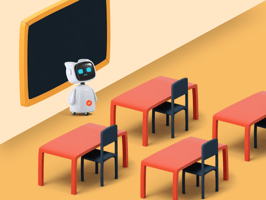With the Redmenta AI-cademy we would like to help teachers navigate the everchanging world of...
Redmenta AI-cademy: From a mysterious hype to a teaching revolution?
With the Redmenta AI-cademy we would like to help teachers navigate the everchanging world of technology and artificial intelligence. It's no longer a matter of how AI works but rather what it can offer to teachers and students.
Artificial Intelligence (or simply AI) has come a long way since its inception in the 1950s when Alan Turing, a computer pioneer and polymath, published his paper and proposed a question: "Can machines think?"
Because, at its core, AI is about automating judgments that have previously been the exclusive domains of humans.
The last decade, in particular, has seen a dramatic chapter of breakthrough innovations - that slowly changed our lives and habits, and it’s just the beginning.
AI in our daily routines
AI takes many forms, yet some people still associate it solely with conversational applications like chatbots.
Whether we are using facial recognition on our smartphones, buying products online, using navigation, endlessly scrolling on social media, or listening to songs on our favorite music streaming service, AI is already impacting our choices in one way or another.
AI in education
AI is not only here to transform our everyday but also the way we teach and learn. Machine learning is revolutionizing the education sector. The possibilities are endless, from personalized learning to content generation, data analysis or closing the gap between students. However, many schools are still struggling to integrate these cutting-edge technologies - says Abhinand Chincholi, in his Forbes article.

In November 2022, we hit a turning point when OpenAI launched its free chatbot solution, ChatGPT. It made essay writing more effortless than ever before but also caused worries among education experts and the academic field. Some schools even blocked access to the page since they were afraid that it would make students cheat on their assignments.
A few months passed, and some teachers already recognize the potential of it. They believe that chatbots can bring interactivity to classrooms, helping students to be more creative, role-play, and think critically. They can generate counterarguments to a student's position and help students with specific learning needs.
Stanford University recently organized its AI+Education Summit to explore how AI can be used to advance human learning. The participants discussed topics such as natural language processing applied to education, developing students’ AI literacy, and avoiding the potential misuse of AI. The potential of AI includes enhancing personalized support for teachers, changing what is essential for learners, enabling learning without fear of judgment, and improving learning and assessment quality.
In conclusion, AI has the potential to revolutionize the field of education and provide countless benefits for schools. However, it also brings significant risks and emerging challenges, such as ethical concerns of the ambiguities over authorship and copyright or the deep fake phenomenon.
In the upcoming weeks, we’ll continue exploring this exciting technology and how to use it wisely to ensure the best possible outcomes for educators and their students.



